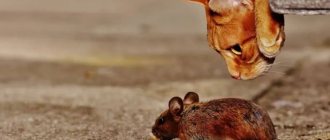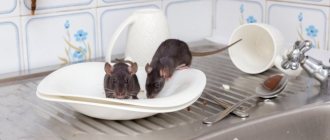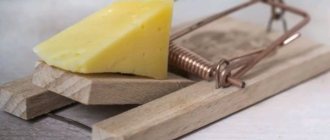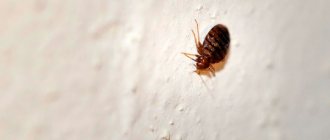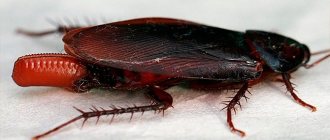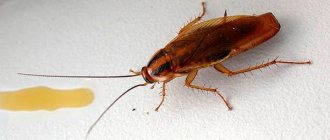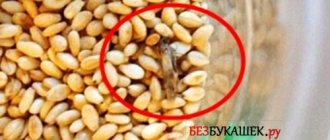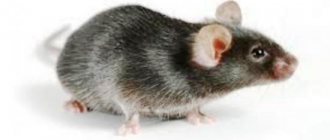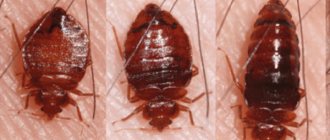You can get rid of mice using a mousetrap, sticky trap, homemade device, ultrasonic repellents or chemicals. Each method has been tested by time and user reviews and is distinguished by certain features. Let's look at the most popular and effective methods of rodent control using specific examples.
How to get rid of rodents in the house Source parazit.guru
Physical methods
There are many types of mousetraps, traps and traps for mice. The difference lies in the mechanism of action and the principle of catching rodents. Compact devices are easily installed in mouse habitats, where they often pass in search of food. The most popular types of physical mouse traps are those presented below.
Classic mousetraps
The advantage of classic mousetraps is the possibility of repeated use immediately after the caught animal is removed. To do this, install a new bait and cock the return spring. You don’t have to do anything else; replacement of parts and consumables is not provided here.
Trap
This refers to a metal cage with a raised door. The bait lies in the far corner and presses the thread that holds the locking mechanism. The principle of operation of the device is that the animal enters the cage, heading towards the bait, releases the thread, thereby closing the door, the mouse remains inside.
Another type of mouse trap is a small box with an entrance that only works in one direction. Having caught the aroma of bait, the rodent gets inside, but is no longer able to get out.
Electrical accessories
An electric mouse trap can be powered by AA batteries or from an outlet. The device is built on the principle of placing bait inside an energized zone. The mouse sees a tasty morsel and moves towards it, stepping on the wires and receiving an electric shock, the value of which is sufficient to cause its death.
Electric traps are quite popular and differ in size and the presence of additional options, for example, it can be a chamber for storing corpses, sound or light indicators of capture.
Important! The devices operate on electricity. When the batteries are disconnected or low, they turn off.
Glue trap
An equally effective way to control rodents. Presented in the form of a regular plate treated with a sticky non-toxic composition. The mice become glued to the base, unable to free themselves.
Important! When using such devices, you need to be prepared to peel the caught mouse off the base while it is still alive. As an alternative, many people throw away the stickers along with the caught animal.
Flower pot
If you have a flower pot at home (made of plastic or clay - any will do), which also has a hole in the bottom, use this method.
Just keep in mind that the plastic pot will need to be weighed down with a small weight.
You will also need: a toothpick or a regular match, a piece of plywood, thread, a paper clip and, of course, bait.
So, turn the pot upside down on a piece of plywood. Take the thread and pull it through the hole at the bottom.
Tie a toothpick to a thread on the outside of the pot, and attach bait on the inside (a paper clip will come in handy here). Try to attach the mouse bait as close to the bottom as possible.
When everything is ready, rest the top edge of the pot on a toothpick that is tied to a thread and wait: as soon as the curious animal decides to climb for the treat, the toothpick will work like a trigger and the mouse will cover the pot.
Homemade traps
Do-it-yourself mousetraps are simple, uncomplicated devices that are no different in effectiveness from store-bought ones. And some may even surpass them in terms of the number of “catch”.
Important! When designing a homemade trap using a container (cans, bottles), use sunflower oil. By pouring it inside, you will make the animal’s paws become oily, which will not allow it to escape, moving along the inner walls of the vessel.
One and a half trap
Only a bottle with a standard narrow neck is suitable for this. The 5-liter is not suitable due to the wide neck. The procedure is as follows:
- Tie a strong thread or rope to the neck.
- The other end is to the top of the table leg.
- Place bait inside.
- Place the bottle horizontally, so that at least 2/3 of the bottle hangs from the table.
Trap in action Source cdn.fishki.net
The meaning of the trap is that the mouse, having penetrated the bottle, will run to the bait. Once in the back (hanging part), the container will tilt, it will tilt and fly down. The cord will not allow the bottle to fall - this way the trap will be suspended in the air, and the rodent will not be able to get out due to the narrow hole.
Trap from a jar, bucket
The principle is that the upper part of the container is sealed with paper, in which an incision is made crosswise. The bait is placed inside. To increase the effectiveness of the method, build a bridge for the mouse, making it easier for it to get up to the paper false cover. In this case, it is enough to lean against an ordinary ruler or a branch brought from the garden.
Trap with false lid Source i5.otzovik.com
The point of the trap is that, sensing the smell of bait in the bucket, the mouse falls on the paper lid and falls through the cuts made. She won't be able to get out because her paws are stained with oil.
Salt trap
Pour water into a bucket and make a strong salty brine in it. You can hide the liquid by adding sawdust. Their quantity should be such as to completely cover the surface after swelling. Place fragrant bait in the central part. Next, you can organize a bridge from a wooden ruler, or you can leave it without it. The principle of operation of the trap is that a rodent, driven by the desire to eat the bait, steps onto sawdust or a bridge and falls into the salt concentrate. He will no longer be able to get out of it.
Glue trap
In this case, you will need special mouse glue. The consistency is spread on cardboard or something else, and the bait is placed in the center. A mouse caught in glue cannot free itself and dies from dehydration.
Glue trap for rodents Source i5.otzovik.com
Important! The disadvantage of this method is that the trap is considered disposable. It has to be thrown away along with the dead mouse.
Wooden house
Assembling a wooden house is one of the most labor-intensive ways to catch mice using improvised means. The principle of the device is that a box is assembled that looks like a birdhouse, but with entrances not in the front, but on the sides.
It should consist of two parts: the bait is suspended in the upper one, and the lower one is used as a place for imprisoning mice. To prevent escape as a result of a chewed board, line the inner walls of this area with tin. Between the top and bottom, a bridge is made of two planks with springs holding them in a horizontal position. Under the weight of the rodent, they bend - the animal falls into the lower part. The released board-bridge rises to its original position and is ready to receive the next visitor.
We do it ourselves
If you are in the country and there is no store nearby, then you can make a device for catching a rodent with almost your bare hands. A humane mousetrap made from a plastic bottle will serve you faithfully. Any mineral water or juice bottle will do for this.
Moreover, you don’t need anything else to succeed. Open the lid and carefully pour a few tablespoons of vegetable oil inside. Place bait, which can be fried sunflower seeds. The smell will attract rodents. This is a humane mousetrap, because other than slight bewilderment, it will not cause any concern to rodents. The bottle is placed at an angle. It is very convenient to fix it with books. You can lay out several pieces as steps along which the mouse will climb into the bottle. Be sure to secure the edges with tape to prevent the bottle from tipping over. Otherwise the mouse will simply run away.
High-tech repellents
An ultrasonic or electromagnetic repellent is a device that generates high-frequency sound waves that repel rodents. Repellers are installed in premises occupied by pests, connected to the electrical network and left for 15-20 days.
Replent for mice and rats Source carcam.ru
Ultrasonic rodent repeller Source carcam.ru
The peculiarity of the device is that the rodents do not die, but are moved to another place, since they cannot tolerate prolonged ultrasonic exposure.
- Ultrasonic repellers show excellent results. The operating principle is based on ultrasound radiation, which negatively affects the nervous system of rodents.
- Electromagnetic emitters, generators of alien radiation - it is possible that such devices cope with insects, but they do not help against rodents.
- Combined devices are devices designed to protect premises from pests of various origins. They can operate in the mode of emitting ultrasound or electromagnetic waves. Although they belong to the universal type, they have weak results. Therefore, if you have set yourself the task of driving mice out of your home, purchase only a separate model of an ultrasonic repeller.
Pay attention to a number of factors that can improve or, conversely, reduce the effectiveness of its use. They are as follows:
- Thick walls can reflect the signal into the room, thereby increasing propagation within a single room. The disadvantage is the small coverage area, limited by the size of the room.
- The maximum effect is achieved when repellers are located in open spaces and rooms. In busy passages, rodents will move behind the obstacle, and ultrasound will be scattered between things. Thus, the result will be weak.
- The best place to place the repellent is in the center of the room. The device should emit waves throughout the room, and not in the direction of one point.
- Do not leave food within the reach of mice. If there is an abundance of food, no repeller will help get rid of rodents.
What damage can mice cause?
Even one mouse can cause significant harm, and if several of them sneak into your home, this is an emergency. In addition to the fact that mice cause harm, many housewives are also afraid of them, causing panic in the house or apartment when they accidentally appear. Often these people have high blood pressure due to nervous stress, which can lead to heart attacks.
As a result of the vital activity of mice, you can count on the following consequences:
- Infection with dangerous diseases is possible, since rodents are carriers of dangerous microorganisms.
- The possibility of a fire in a house or apartment as a result of a short circuit due to damage to the insulation of the electrical wiring.
- Damage to food and household property.
- The presence of an unpleasant odor in the home from the results of their vital activity.
Chemicals
Chemicals used to control mice in the home guarantee 100% rodent mortality. The range of products is varied and is divided into several groups:
- Preparations of herbal and synthetic origin with maximum effectiveness of the latter.
- Release form: granular, powdered tablets, liquid, gel, cream. A separate category are aerosol-type substances intended for surface treatment. In this case, the rodent comes into contact with the resulting coating, particles of poison fall on the fur, from where it gets inside the animal (after licking, which we call washing).
- Method of exposure, divided into drugs with immediate and chronic action. In the first, the substance poisons the mouse immediately after entering the body, in the second, it kills within 2-3 days. The point of prolonged exposure is to ensure that animal corpses do not accumulate near the feeder with poisoned bait. In this case, others will avoid her.
- According to penetrating abilities. Here drugs are classified into 3 groups. Fumigants are substances that enter the body through the lungs, intestinal substances are those that must be eaten, and contact substances are those that act through the skin.
Poison packaged in bags Source stopklopu.com
Domestic rat poison Source severdv.ru
Gel remedy against mice and rats Source vrediteli24.ru
Important! Poisoning mice with chemicals is an effective remedy, but it has one significant drawback: after the rodent has eaten the poison, it crawls away and dies there, in its burrow, under the baseboard, inside the gypsum board partition. In general, where it is quite problematic to get it from.
Get a cat
Another time-tested way to catch mice at home is to get a cat. This method has many advantages:
- Cats, like mice, are very smart animals. And they change their hunting tactics depending on the behavior of mice
- Cats can track mice for a long time
- They smell the appearance of rodents, that is, they are the best watchmen
- Can get an animal from any hiding place
- Nice family members or neighbors
It would be better, of course, if it were a fighting rat-catcher cat.
However, this method also has its drawbacks. Cats are living beings, and by having them even in a garage or store, the owner takes responsibility for them. It is neither ethical nor humane to abandon an animal to its fate when moving. Unfortunately, dozens of volunteers take these orphaned animals in the fall from dacha villages, where they are kept for the summer to catch rodents.
The mice will leave on their own as soon as they smell the cat in the house.
The cat requires care, including veterinary control. Since mice are carriers of fleas, lice and ticks, when hunting, the cat will inevitably receive uninvited guests. Then the insects can settle in the apartment or basement and attack people. Flea bites are very painful. At the same time, through a flea bite, a flea transmits various viruses and infections, as well as worm eggs. In order to avoid such troubles, the cat’s fur should be regularly treated to remove insects, and a flea collar should be put on it.
If mice have settled in the apartment, the mustachioed pet will quickly catch them.
In addition, the animal must be vaccinated. When hunting, a cat bites mice, which means that various diseases are also transmitted through blood. Otherwise, the mouse hunter can cause serious harm by becoming a carrier of diseases such as plague, cholera and others.
A beautiful, well-groomed and vaccinated cat will become the best guard against rodents and a good, reliable friend.
Traditional methods
Folk methods involve a wide range of devices and methods for destroying or removing mouse brood. While we have already looked at homemade traps, we have not yet studied means that can drive away harmful neighbors.
A mint solution is effective in controlling rodents Source stroy-podskazka.ru
Coriander (cilantro) against mice Source autogear.ru
Yellow tansy flowers Source parazitdoma.ru
Peppermint
Peppermint is often used to control mice. This is an accessible, cheap and effective remedy. The aroma of the plant is pleasant to human charm, but intolerable to rodents. The herb can be used in one of 3 ways:
- Place grass in the corners of the room, plant a plant in the local area.
- Brew a strong decoction and spray the areas where mice were spotted.
- Soak rolled cotton balls or disks in the broth and place them in the corners of the room.
Cleanliness is the enemy of the rodent
By keeping the house clean and following the recommendations, you can create conditions that become unbearable for mice to live in and they quickly retreat back home.
- Periodic general cleaning will help to avoid the accumulation of garbage, leftover food in corners, table drawers and other inaccessible places, and therefore rodents will not have the opportunity to profit from anything.
- Products are stored in tightly sealed jars or metal containers with a heavy lid.
- Household and kitchen waste is collected in buckets with lids and removed from the apartment in a timely manner.
- Install grilles on ventilation ducts, seal holes in the floor and baseboards.
Operating principle
A humane mousetrap of this design is best placed on steps or on shelves. In such places mice are caught very quickly. The mouse climbs into the bottle following the smell of the fragrant filling. And vegetable oil prevents her from getting back out. For the same purpose, you can use a glass bottle, for example, a beer bottle.
In this way, you can catch not one, but several rodents at once in one bottle. If you catch one mouse, you can release it and return the trap to its original place.
The simplest design
Even a schoolchild can assemble it. To do this, you need to build a box with an open top and without one wall from glue and cardboard. We make a hole in the side walls for a pencil. Now we need a bottle with holes. Bait is placed at the bottom, after which the bottle is fixed in the box. When the rodent gets close to the treasured pieces, the bottle is overweight - and the exit to the outside is cut off. Now the little creature is entirely in your power.
Bait Products
Many cartoons and even films have created a stereotype that the favorite treat of rodents is cheese. But this is not true at all. The mouse, of course, will eat this food, but if it has a choice, it will choose the following foods:
- Fragrant sunflower oil. Unrefined is also suitable.
- Bread.
- Cookie.
- Any types of nuts.
- Smoked fish.
- Raw and salted lard.
- Sausage. They especially prefer smoked.
These products are great for use in any trap. They will be used as bait. A hungry animal will not be able to resist and run past, but in any case it will taste the treat. This is what will help you catch her very quickly, luring her out of her hiding place.
Where is it relevant to use the most popular plants?
Often this method is suitable for private homes. After all, many of these plants are shrubs. As a preventive measure, you can protect the space around you from rats by planting several bushes in front of your house or along it. Scatter the branches around. Henbane, blackroot, datura, black elderberry and castor bean are some of the most popular organic rodenticides.
As for flower beds in the country, chamomile, calendula, hydrangea and daffodil planted together will help you. In addition to their main purpose, flowers can repel ticks, bedbugs, mosquitoes, ants, fleas and insects. During flowering, they will delight you and your family and save money on rodent control products. Just plant bushes throughout the garden around your home and live in peace.
How to understand that there is a mouse living in the house
- If there is a mouse in your house, you may hear it. From time to time she squeaks, scratches, gnaws and scratches. This is especially audible at night, when extraneous sounds in the house fade away.
- The most important indicator of an unwanted tenant in your home is chewed bags of cereals, damaged fabric bags in which dried fruits, nuts or other food supplies are stored. You may also see food debris or seed skins in the corners of the farthest drawers.
- In places where mice live most often, you can find rodent excrement. They are very easy to confuse with garbage - they are black and dry.
- Very often, in a house where a mouse lives, the baseboards are gnawed, holes are noticeable in the shaft, and there are significant gaps along the water pipes.
- If a mouse has been living in the house for several days, there will be a distinct mouse smell in the room.
DIY mousetrap made of wood
Do-it-yourself mousetrap made of wood
It is more difficult to make a mousetrap from a wooden block, but such a product also lasts much longer, and its efficiency is high.
Manufacturing stages:
- Take a wooden block 10 cm long and 5 cm wide.
- Drill a hole in the block at least 2 cm in diameter with a depth of 7-8 cm.
- Make a cut along one side of the block (width 3-5 mm).
- Drill 3 small holes, placing them perpendicular to the axis of the large hole.
- Bend a ring with an “eye” from the wire.
- Make a spring of 3 turns from spring wire, leaving 7-9 cm at the ends.
- Tie a fishing line or strong thread to the ring.
- Thread the fishing line into 2 small holes one by one and secure.
- Place the ring into the place where the cut was made so that the entrance to the large hole remains free.
- Insert one end of the wire spring into the last small hole, and thread the other through the “ear” of the ring.
The mousetrap is ready, all that remains is to pour nuts or seeds into the large hole and wait for guests. The mousetrap works according to the following principle: the animal follows the smell of the bait, chews off the fishing line that interferes with the passage, the ring falls and pinches the mouse.
